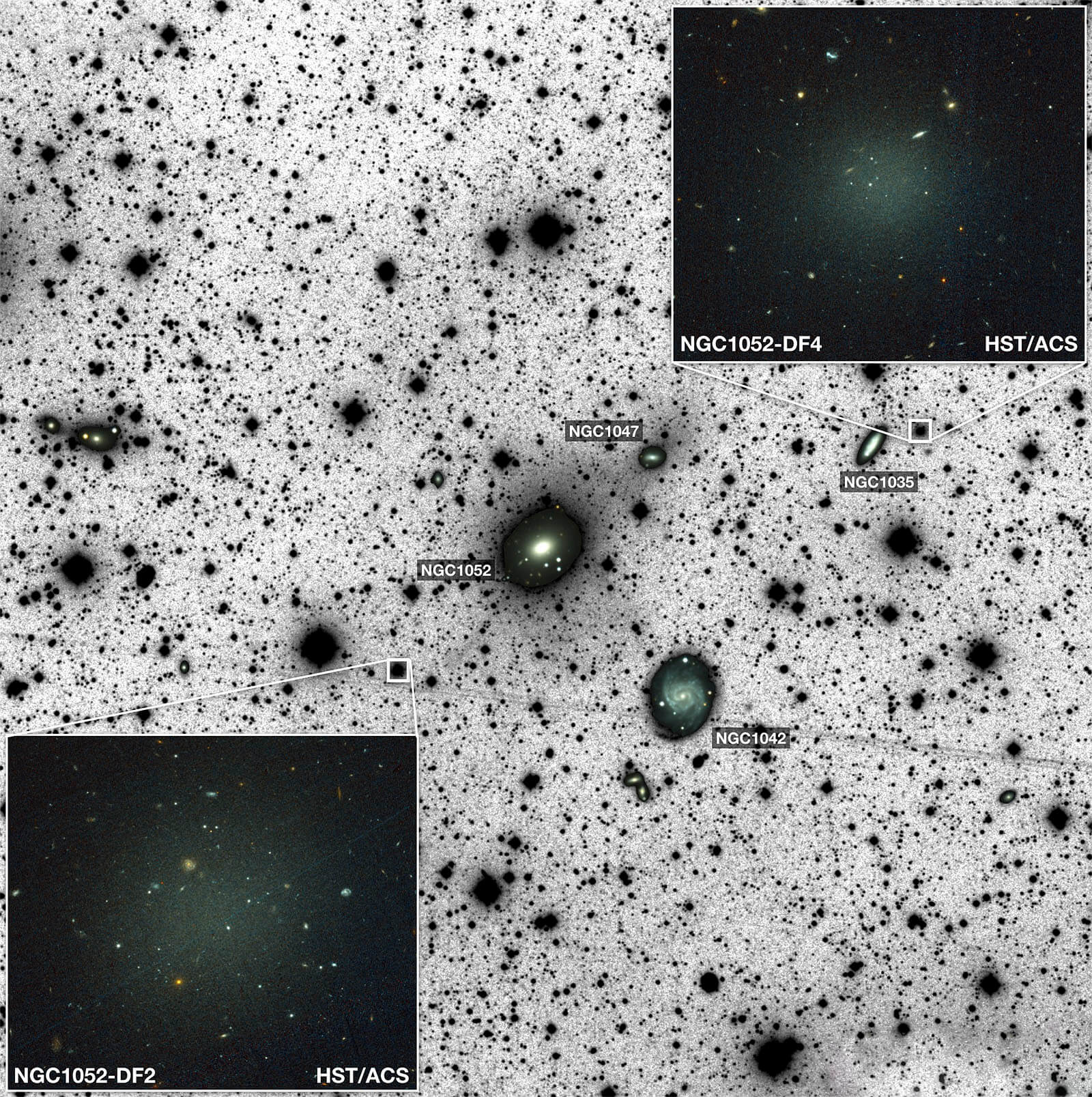Observing a group of elliptical galaxy NGC 1052, located at a distance of 65 million light years from Earth, astronomers discovered the second galaxy containing a small amount of dark matter or completely devoid of this mysterious substance.
The generally accepted theory of the formation of galaxies suggests that their formation requires the presence of a significant amount of dark matter, or rather halo from it, and the unexpected discovery of NGC1052-DF2, consisting only of baryonic matter, naturally caused a huge amount of debate and discussion in subsequent publications. The initial results were thoroughly checked, criticized, but in the end there were no strong arguments against.
The finding shows that the NGC1052-DF2 galaxy, discovered in 2018, devoid of dark matter, is no exception, and there is a whole class of such objects. However, the origin of these large, dim galaxies with an excess of bright globular star clusters and the apparent absence of dark matter is currently unclear.
Galaxies are somewhat like icebergs – the part that we can observe is very small compared to the one that is hidden from us. Therefore, the assessment of mass, which allows to identify their important properties, is reduced to two stages. At first, astronomers sum up all the light visible in the galaxy and convert it into its equivalent star mass. Although there are many reservations in this approach, since it strongly depends on the type of stars responsible for the main luminosity of the galaxy, it still gives the necessary accuracy of calculations.
However, the stellar mass is only the tip of the galactic iceberg, and to measure the total mass of the galaxy (including matter that does not emit light), scientists move to the second stage, in which they measure the speed of objects inside and around it under the influence of gravity.
For spiral galaxies similar to the Milky Way or Andromeda in which most objects rotate in the same direction, estimating the total mass is reduced to a simple measurement of the circular velocity of stars far from the center and using the virial theorem. In elliptical and dwarf galaxies, everything is a bit more complicated: the stars move in random directions. In such cases, astronomers have resorted to obtaining velocity dispersion (statistical variation of velocity values around the average for a group of objects), which also allows us to calculate the total mass. Since these approaches are based on the movement of objects, the resulting mass is called dynamic.
It turns out that the dynamic mass of the galaxy is usually 5-10, and in some cases up to several hundred times greater than the “visible” mass. The reason for this significant discrepancy, according to astronomers, is the presence of a large, completely invisible component of the galaxy called “dark matter halo”. The current understanding of the formation of galaxies and large-scale structures in the universe is based on the assumption that they all form in halos of dark matter.
Therefore, the discovery of the galaxy NGC1052-DF2, whose stellar and dynamic masses are almost identical, came as a complete surprise and gave rise to much controversy. However, the method used to calculate the dynamic mass of NGC1052-DF2 and based on the movement of bright clusters of stars has recently been independently verified, the result of which showed full compliance with the initial assessment and reinforced the conclusion that NGC1052-DF2 is devoid of dark matter.
After confirming the main problem, it became clear whether this galaxy was just a statistical accident and how it could appear. There is still no answer to the second part of the question, but it seems to have been found to the first.

The team of astronomers who discovered NGC1052-DF2, using the same tools and the same approach, calculated the dynamic mass of another galaxy with the designation NGC1052-DF4, which turned out to be equal to the visible mass. The study, as in the first case, was carried out using bright globular star clusters.
With the discovery of a second galaxy without an invisible mysterious substance, the question of the exclusivity of NGC1052-DF2 disappears, but many others appear, the main one being: where is the dark matter?
Now astronomers have to uncover the mystery of the NGC1052-DF2 and NGC1052-DF4 galaxies and find out if they have lost dark matter during collisions with other small galaxies or because of its absence is the gravitational effect of a larger galaxy. And most importantly, could they have been formed at all without the participation of dark matter?
Galaxies without dark matter
Click To Tweet
The post Galaxies without dark matter appeared first on Upcosmos.com.
